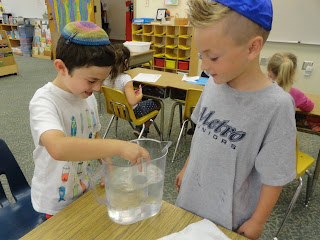Primary began the year in science focusing on flight and how it works. Our eventual goal is to learn how to make and fly airplane models.
At the start of our unit about flight, we asked the students: What do we need to fly?
Their response: air.
They seemed to understand that air is important for flight, but they had difficulty explaining why. Therefore, we began our investigation learning the basics about air!
Some students did research about different topics surrounding air and learned how to conduct experiments that would model these concepts. In preparation for teaching the other students, they practiced demonstrating and explaining what was happening.
Question one:
Is there air inside a jar?
This ping-pong ball was pushed down in the water by using the air in the jar. Also, the air in the jar prevented the napkin from getting wet when the jar was pressed down into the water.
Question Two:
What is air?
As seen by these balloons getting bigger when air is pushed into them, air takes up space.
Question Three:
How can we see air?
Since air is invisible, how do we know it's there? The wind!
These students were taught how to make pinwheels. They used their breath to blow air on the pinwheels to see air at work.
Question Four:
Does air take up space?
Students got to see that when the opening of a cup is put down into a pitcher of water, the inside of the cup remained totally dry. Where there is air, the water cannot go because the air takes up space.
If the cup is tilted, though, the air escapes as bubbles and water goes into the cup.
Question Five:
Does air have weight?
This student placed a deflated playground ball on a scale to determine its weight.
Then, air was pumped into it and weighed again. The full ball weighed slightly more than the empty one, therefore, air has weight!
___________________________________________________
Now that we understood the basics about air, we conducted a couple experiments using those principles.
First, a student tried to blow up a balloon inside an empty water bottle.
Because air was already taking up that space, the balloon could not inflate. Once a small hole was poked in the side of the water bottle, though, the balloon could be blown up because the air had someplace else to go.
Next, we learned about at air pressure. Mrs. Hoy lit a piece of paper on fire and put it into a glass jar and a hard-boiled egg was placed in the opening of the jar.
What will happen to the flame and the egg?
Once the flame burned all the air inside the jar, the flame would extinguish. However, since the air had been used, it created low pressure inside the jar. This low pressure caused the egg to be suctioned inside the jar.
Now that we have a solid understanding of air, we will use this information toward learning about flight! Stay tuned!
































No comments:
Post a Comment